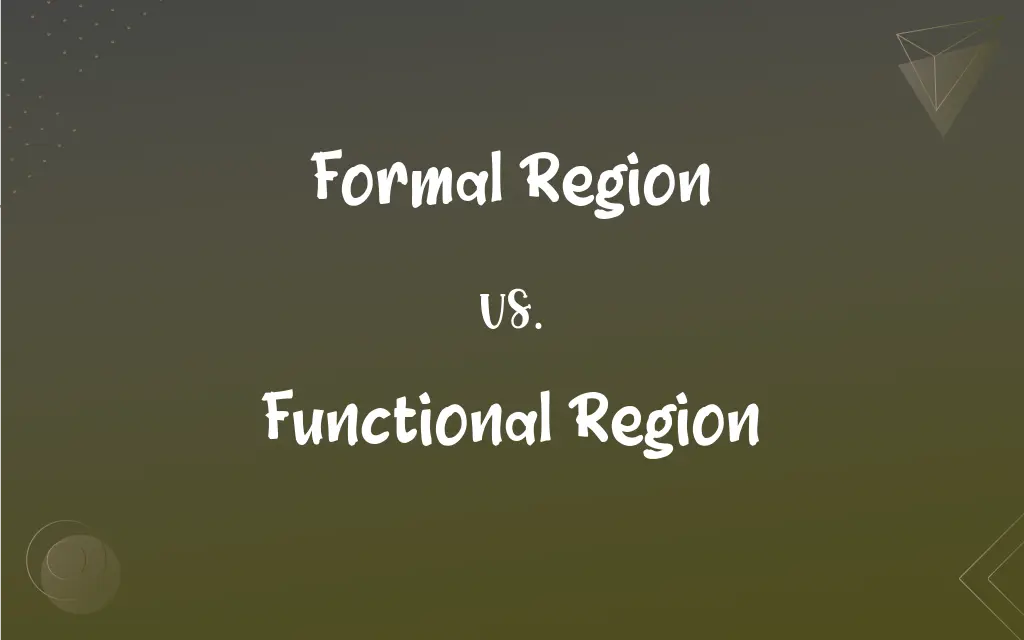Formal Region vs. Functional Region: What's the Difference?
Edited by Aimie Carlson || By Harlon Moss || Published on February 8, 2024
A formal region is defined by uniform physical or cultural characteristics, while a functional region is organized around a central point and defined by an activity or interaction.

Key Differences
Formal regions are areas defined by a commonality in physical or cultural attributes, such as language or climate, while functional regions are defined by a specific function, often characterized by a point of connectivity or a central hub.
In a formal region, the defining traits are homogeneous and consistent throughout the area, whereas in a functional region, the defining traits are interactions or connections that typically radiate from a central point.
Formal regions are often used in geographic and cultural studies to classify areas with similar characteristics, while functional regions are used in urban planning, economics, and transportation studies to understand and manage areas based on their functional dynamics.
The boundaries of a formal region are defined by the uniformity of the characteristic, whether it be linguistic, climatic, or another trait, in contrast, the boundaries of a functional region are often determined by the extent of influence or interaction, such as the reach of a metropolitan area.
Examples of formal regions include the Sahara Desert (characterized by its arid climate) and French-speaking Quebec (unified by language), while examples of functional regions include the catchment area of a river or the commuter belt of a city.
ADVERTISEMENT
Comparison Chart
Defining Characteristic
Uniform physical or cultural traits
Specific function or activity
Boundary Determination
Homogeneity of a trait
Extent of functional influence or interaction
Usage
Geographic and cultural studies
Urban planning, economics, transportation
Example Traits
Language, climate, vegetation
Transportation networks, economic activities
Typical Examples
The Rocky Mountains, the Corn Belt
Silicon Valley, the New York metropolitan area
ADVERTISEMENT
Formal Region and Functional Region Definitions
Formal Region
It is a geographical area characterized by a certain level of homogeneity in natural or human characteristics.
The Great Plains of North America is a formal region known for its flat terrain and grasslands.
Functional Region
It is a region defined by a system, like a transportation or economic network.
The London Underground service area is a functional region for transportation.
Formal Region
It is a region characterized by a uniformity of a specific cultural or physical feature.
The Amazon Rainforest is a formal region defined by its unique ecosystem.
Functional Region
A functional region is an area organized to function politically, socially, or economically as one unit.
The San Francisco Bay Area functions as a single economic region.
Formal Region
A formal region is an area defined by official boundaries.
The state of Texas is a formal region within the United States.
Functional Region
A functional region is centered around a node or focal point with a specific function.
Silicon Valley is a functional region centered around technology and innovation.
Formal Region
Formal regions are often demarcated by governmental or administrative boundaries.
The borders of France define it as a formal region with specific legal and administrative functions.
Functional Region
This type of region is characterized by a central hub or point and the areas affected by it.
The catchment area for a major port or airport is a functional region.
Formal Region
A formal region refers to an area where a certain cultural identity is prevalent.
The Basque region in Spain is a formal region with a distinct cultural identity.
Functional Region
Functional regions are often dynamic and can change based on the function or activity.
The commuter belt of New York City is a functional region defined by daily work travel patterns.
FAQs
Are formal regions static?
Yes, formal regions generally have stable characteristics, like climate or language.
What defines a formal region?
A formal region is defined by uniform physical or cultural characteristics.
What is an example of a functional region?
An example is a metropolitan area like Greater Los Angeles, organized around urban functions.
How is a functional region organized?
A functional region is organized around a central point or node, defined by specific activities or interactions.
Can a formal region have varied characteristics?
No, a formal region is characterized by homogeneity in its defining traits.
How are the boundaries of a functional region determined?
Boundaries are determined by the extent or reach of the central function or activity.
Can a city be a formal region?
Yes, a city can be considered a formal region if defined by administrative boundaries.
Is a formal region influenced by human activities?
A formal region can be influenced by both natural and human factors, like vegetation or cultural practices.
What roles do functional regions play in urban planning?
They are crucial for understanding transportation, economic activities, and urban dynamics.
Do functional regions affect commuting patterns?
Yes, they can significantly influence commuting and residential patterns.
How are formal regions used in cultural studies?
They are used to study areas with shared cultural traits like language or religion.
Can the size of a functional region change?
Yes, it can change based on the development or decline of the central function.
Are country borders an example of a formal region?
Yes, country borders often define formal regions with legal and administrative homogeneity.
How does transportation define a functional region?
Transportation networks like subway systems can define the functional extent of a region.
Are functional regions important for economic development?
Yes, they play a key role in shaping economic policies and development strategies.
Can functional regions overlap?
Yes, functional regions can overlap, especially in areas with multiple central functions.
Is a formal region always legally recognized?
Not always, some formal regions are culturally recognized without legal status.
Can a formal region be identified by its climate?
Yes, areas like the Mediterranean are formal regions identified by their specific climate.
Can a language define a formal region?
Yes, areas where a specific language is dominant can be considered formal regions.
What differentiates a functional region in economic studies?
It's differentiated by its economic activities, like a trade or industrial zone.
About Author
Written by
Harlon MossHarlon is a seasoned quality moderator and accomplished content writer for Difference Wiki. An alumnus of the prestigious University of California, he earned his degree in Computer Science. Leveraging his academic background, Harlon brings a meticulous and informed perspective to his work, ensuring content accuracy and excellence.
Edited by
Aimie CarlsonAimie Carlson, holding a master's degree in English literature, is a fervent English language enthusiast. She lends her writing talents to Difference Wiki, a prominent website that specializes in comparisons, offering readers insightful analyses that both captivate and inform.







































































